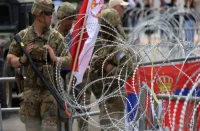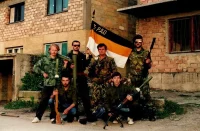Boshnjak, Bosnia-Herzegovina, Bosnian
One of the main problematic issues concerning the ethnolinguistic-statehood reality of the Boshnjaks is the fact that their ethnic, language and state’s names are not having the same terminology as it is championed by the majority of the European nations (ex. Polish nation; Polish state; Polish language, etc.). In the other words, their ethnonational name – “Boshnjaks” does not correspond to the name of their national state – “Bosnia-Herzegovina” and both do not correspond to their national language name – “Bosnian”. In this context, we can wonder, for instance, which language speak population in Herzegovina or why the Boshnjaks does not speak today the Boshnjak language but instead speaking Bosnian one? In this place, it has to be said that originally from 1991 up to 1996 the Boshnjaks pretended to officially speak the Boshnjak language (but never tried to rename Bosnia-Herzegovina into “Boshnjakia”). Such practice was even internationally sanctioned by the Dayton Peace Treaty in November 1995 when the text of the agreement was signed in four languages: English, Croatian, Serbian, and Boshnjak (but not Bosnian!).[i] However, very soon the ideologists of the Boshnjak ethnonational identity understood that international science of Slavonic philology is very suspicious upon the use of the Boshnjak language as it is not at all rooted in the historical sources in which from the year 1300 up to 1918 is mentioned only the Bosnian language (but, in fact, as a provincial language spoken by the Orthodox, the Catholic and from 1463 onward the Muslim communities).[ii] The elevation of the Bosnian language, allegedly as a mother tongue of all inhabitants of Bosnia-Herzegovina was especially promoted at the time of the Austro-Hungarian administration in this province from 1878 to 1918.[iii] However, such a solution was decisively rejected by both the Serbs and the Croats from Bosnia-Herzegovina who called their languages after their ethnic names. Thus, the idea of the Bosnian language at that time (as today as well) was accepted only by the local Islamic inhabitants.[iv]
Nevertheless, the Austro-Hungarian policy of introducing of the Bosnian language as a native one of all inhabitants of Bosnia-Herzegovina is accepted today in a full extent by the main advocators of the Bosnian language as a mother tongue of the Serbs, the Croats, and the Boshnjaks from Bosnia-Herzegovina but as well as and of the Boshnjaks from the Sandžak region (Рашка in the Serbian language and historiography). Sandžak (or Sanjak) was divided after the 1912−1913 Balkan Wars between Serbia and Montenegro but before 1878/1908 being a part of the Ottoman province (pašaluk in the Serbo-Croat) of Bosnia (but not of Bosnia-Herzegovina!) which existed from 1580 to 1878/1908.[v] There is also an unproven claim (in the sources) that even before Slavic settlement at Bosnia (the 7th c.) existed such name of Bosnia for both Bosnia-Herzegovina and Sandžak.

The truth is that in the 15th and the 16th centuries the “Bosnian” (or the “Serbo-Croat” or the “Serbian” or the “Croat”) language was second diplomatic and official language at the court in Istanbul (after the Turkish one) due to the fact that at that time there were many highest Ottoman officials and the Janissaries[vi] in Istanbul (including and Grand Viziers) originating from Bosnia-Herzegovina.[vii] However, this fact became a basis for the claims that exactly Bosnian language was at that time some kind of Balkan lingua franca and even one of the most diplomatic languages in Europe. Nevertheless, the sources are telling us that in the most cases the local South Slavic population of the ex-“Serbo-Croat” language (especially those from the Republic of Dubrovnik) have been calling their language as “our language”, “Slavic language”, “Illyrian language”, etc., but only in very rear cases by ethnic names.[viii]
Linguistic engineering
The creators and promoters of the modern idea of a separate Bosnian language from the relative neighboring ones, in order to prove their standpoint, implied the technique of “linguistic engineering”, similar to their Croatian colleagues concerning the Croatian language.[ix] In both cases, it was and is done for the very purpose to prove that their ethnic groups are linguistically independent what has to give them a right to call themselves as a separate nations who are justifiably struggling for their own independent political entities which have to be internationally recognized as independent nation-states according to the rights to self-determination. However, differently to the Croatian language case, the Bosnian language “linguistic engineering” is not based on the introduction of neologisms[x] but rather on re-introduction of the Oriental words from the Turkish language which have been brought to the Balkans by the Ottoman authorities.
It can be said that the problem of official recognition of a separate Bosnian language, as the newest Slavic one, in 1996 can be solved taking into consideration two standpoints:
- A linguistic standpoint.
- A socio/polito-linguistic standpoint.
De facto (linguistically), the Serbian, the Croatian, the Bosnian, and the Montenegrin languages are still belonging to one standard-linguistic system. They express unity in orthography, grammar, morphology, syntax, phonology, and semantics. For instance, all of them have 30 phonemes (25 consonants and 5 vocals). Between them, there are only up to 8% lexical differences (including and “neologisms”).
However, there is a tendency to create lexical differences for the sake of lesser inter-understanding in order to firmly justify ethnolinguistic and state-political “independence” from, in fact, the same, ethnolinguistic neighbors. The obvious fact is that the level of inter-understanding is almost 100% (including the newest neologisms too).
De Iure (in socio/polito-linguistic point of view) these four languages are formally separate ones as they are already internationally recognized (including the Montenegrin language as well as). However, the Serbian, the Croatian, the Bosnian, and the Montenegrin are separate languages according to the names, almost no different according to the essence and no separate in structure.

The crucial technique of “linguistic engineering/surgery” of the Bosnian language is its lexical Orientalization with the three sociolinguistic and ethnonational tasks to be achieved:
- Inner homogenization of the Boshnjak
- Denationalization of the Croats and the Serbs within Bosnia-Herzegovina (by the suggestion that all inhabitants of this state speak the Bosnian language).[xi]
- External heterogenization of ethno-confessional Boshnjak nation in relation to the neighboring Serbs and Croats.[xii]
The politics of “linguistic engineering” or “linguistic surgery” in the case of the Bosnian and the Croatian languages was implied for the final aim to create firstly independently standardized national languages within officially common Serbo-Croatian one (during the ex-Yugoslav federation) and later (after the destruction of the Socialist Federal Republic of Yugoslavia in 1991) internationally recognized separate languages by deepening and using as much as the dialectical/regional differences of the same spoken ex-Serbo-Croatian language. The ultimate result was that minor speaking differences were proclaimed for the national characteristics and as such have been used to be the foundations of the newly declared autonomous national languages. Consequently, common ex-Serbo-Croatian language ceased to exist and with it a common Serbo-Croatian nationality as well.
Conclusion
Finally, the Slavonic Muslim community in Bosnia-Herzegovina in the 20th century passed the way from the religious community in inter-war royal Yugoslavia, via nationhood in the post-WWII socialist Yugoslavia to statehood in the post-Cold War era[xiii] with the final codification and internationally recognized their own national language. However, the Boshnjaks, the Croats, and the Serbs from Bosnia-Herzegovina (likewise from Montenegro, Sandžak or ex-Republic of Serbian Krayina) all speak the same language which in the 20th century came to the existence under the official name of Serbo-Croat[xiv] and have a shared historical past. The only difference between them is the discrete confessions.[xv] If one will apply the German Romanticist criteria upon the ethnonational identity of/among the Yugoslavs surely at least all Shtokavians (all Serbs, all Montenegrins, all Boshnjaks and the majority of the Croats) would be considered as a single ethnolinguistic nation with the right to live in their nation-state organization which we can name as Shtokavia.
Reposts are welcomed with the reference to ORIENTAL REVIEW.
Endnotes:
[i] Wyn Jones, G. (ed.), Eastern Europe and the Commonwealth of Independent States, Europa: London, 1997, p. 98.
[ii] In historical sources, the name Bosanski jezik (the Bosnian language) is mentioned for the first time in the year of 1300 (“Historijat jezika i države” in http://www.bosnianlanguage.com). It is true that the earliest Slavonic philologists like P. J. Šafaŕík, J. Dobrovský, and J. Kopitar used the term Bosnian language but only as provincial speech of all inhabitants of the Ottoman Pašaluk of Bosnia but not as a language of Bosnians in ethnic term (Петар Милосављевић, Систем српске књижевности, Требник: Београд, 2000, pp. 67–68).
[iii] For instance, according to the decree of 1880 for Austro-Hungarian administration in Bosnia-Herzegovina, existed only the Boshnjaks who are by confession divided into those of the Muslim, the Catholic, and the Orthodox denominations: “Vlada u odnosu na domaće stanovništvo u Bosni i Herzegovini zna samo za Bošnjake koji se po vjeri dijele na muslimane, istočno-pravoslavne i katoličke hrišćane” (Arhiv Bosne i Hercegovine, Sarajevo, Zajedničko ministarstvo finansija, № 6687/Bosna i Hercegovina, 1880). To be more precise, the regime of Benjámin Kállay (the Austro-Hungarian Minister of Finance in 1882–1903) in Bosnia-Herzegovina promoted the bošnjaštvo (the Bosnianism) in order to create a local patriotic loyalty to Bosnia-Herzegovina but not to independent Serbia or even Croatia (which was already a member of Austria-Hungary). Especially the Serbian irredentistic policy was of extream danger for the territorial integrity of the southern part of the Dual Monarchy particularly after military success of Serbia during the First and Second Balkan Wars (1912–1913) when the popularity of the idea of Yugoslavia among the Austro-Hungarian South Slavs became extremely high. That was a reason why the Austro-Hungarian administration in Bosnia-Herzegovina during WWI tried to suppress any Serbian identity of the province usually by the promotion of the bošnjaštvo. It has to be said that historically (at least simple) majority of inhabitants of Bosnia-Herzegovina have been the Serbs as it shows, for instance, the first post-WWII census in Bosnia-Herzegovina (after genocide against the Serbs committed by the Croats and the Muslims) in 1948: the Serbs – 1.136.116 (including 71.125 of Muslim religion); the Croats – 614.142 (including 24.914 of Muslim religion), and the Muslim undetermined – 788.384 (Robert J. Donia, John Fine, Bosnia and Herzegovina: A Tradition Betrayed, Columbia University Press: New York, 1994, p. 176). What concerns the linguistic policy of the Austro-Hungarian authorities in Bosnia-Herzegovina, the first official language in this province to be announced was Croatian. The name was changed after the protest of the local Serbs firstly into the Land language (“Land sprache”) and finally into the Bosnian one. In the schools, it was also used from 1907 and the Serbo-Croat language (M. Pacić, “Prosvetna politika Austro-Ugarske u Bosni i Hercegovini”, Jugoslovenski narodi pred Prvi svetski rat, Beograd, 1967, pp. 703–724).
[iv] It has to be emphasized that even before the Austro-Hungarian administration in Bosnia-Herzegovina the local population used the terms Bosnian (“bosanski”) for the language and the Bosnians (“Bosanci”) for themselves as inhabitants of this province alongside with more pure ethnic names the Serbian/Serbs and the Croatian/Croats (Miloš Okuka, Eine Sprache ― viele Erben. Sprachpolitik als Nationalisierungsinstrument in Ex-Jugoslawien, Klagenfurt, 1998, p. 47).
[v] The Ottoman Pašaluk of Bosnia before 1683 encompasses and parts of historical territories of Croatia and Dalmatia.
[vi] Vinko Pribojević, a Dominican friar from the island of Hvar in Dalmatia in his De origine successibusque Slavorum (Venice, 1532) pointed out that the Ottoman Sultans appointed many South Slavs as the commanders of his army and that 20.000 of his guard (the Janissaries) are recruited among the Thracians, Macedonians and Illyrians (for V. Pribojević all of them have been the South Slavs – aboriginal Balkan people, speaking one language that was later on called Serbo-Croat). With the help of them, the Ottomans subjugated many states and peoples in Europe.
[vii] Ivan Božić, Sima Ćirković, Milorad Ekmečić, Vladimir Dedijer, Istorija Jugoslavije, Beograd, 1973, p. 141.
[viii] Mavro Orbini, a Benedictine abbot from Dubrovnik, in his famous pan-Slavic book (“the Bible of pan-Slavism”) De regno Sclavorum (in Italian version Il regno degli Slavi), printed in Pesaro in 1601, was very clear telling that all South Slavs are speaking the same language and composing one nation within a wider network of united ethnolinguistic Slavdom (Мавро Орбини, Краљевство Словена, Београд, 1968). More precisely, he inclined to call all speakers of the ex-Serbo-Croat language of the Shtokavian dialect as the Serbs (Никола Радојчић, Српска историја Мавра Орбинија, Београд, 1950). However, a Croatian nobleman of German origin from Senj, Pavao Ritter Vitezović (1652–1713) in his political-ideological-programmatic book Croatia rediviva: Regnante Leopoldo Magno Caesare, Zagreb, 1700 claimed that all Slavs, including and those in the Balkans, originated from the Croats and speaking, in essence, the Croatian language with regional dialects (Pavao Ritter Vitezović, Oživjela Hrvatska, Zagreb, 1997; about Vitezović see in Vladislav B. Sotirović, “The Idea of Greater Croatia in the Seventeenth Century”, Statehood Beyond Ethnicity: Comparative and Trans-National Perspectives in Europe, conference proceeding, Flemingsberg, near Stockholm, 2003, pp. 150–189). The essence of both M. Orbini’s and P. Ritter’s (likewise V. Pribojević’s) writings is that all South Slavs (especially the Shtokavian speakers) are composing one ethnolinguistic group (in modern sense – nation).
[ix] “Linguistic engineering” of the Croatian language can be followed even from 1967 when a majority of the most important Croatian scientific, literal and cultural institutions signed a Declaration upon the name and position of Croatian literal language (“Deklaracija o nazivu i položaju hrvatskog književnog jezika”) requiring for the Croatian language to be officially separated from the Serbian one and purified from the so-called “srbizmi” (the words of a Serbian origin).
[x] The Croatian neologisms, in fact, have to replace both the international words (not translated in the Serbian language) and common Croato-Serbian words in order to make a deeper distance between the Croatian and the Serbian languages for the sake of lesser understanding as a crucial proof that these two languages (and nations) are separated. For instance: korjenoslovstvo (etymology), narječoslovstvo (dialectology), točnozor (sniper), vrhoskuplje (summit), odmoridbenik (tourist), veleprevrat (revolution), etc. (Miloš Okuka, “O osamostaljivanju hrvatskog književnog jezika”, A. Кюннап, В. Лефельдт, С. Н. Кузнецов (eds.), Микроязыки, языки, интеръязыки. In honorem professori Alexandro D. Dulicenko, Tartu University Press: Tartu, 2006, p. 233). There were and such proposals for neologisms which hardly took roots like: okolotrbušni hlačodržač (belt for trousers), uljudba (civilization), vrtolet (helicopter), prosudba (mark), etc. (Владислав Б. Сотировић, Социолингвистички аспект распада Југославије и српско национално питање, Vilnius University Press: Vilnius, 2006, p. 115).
[xi] The first President of post-Yugoslav independent Bosnia-Herzegovina and a leader of the ruling Muslim political Party of Democratic Action (the SDA), Alija Izetbegović, was known as an author of nationalistic Islamic Declaration from 1970 according to which, any form of multicultural and/or multiconfessional cohabitation was not possible for the Muslims who have to establish pure Islamic society firstly by Islamization of the whole Muslim community (Alija Izetbegović, The Islamic Declaration: A Programme for the Islamization of the Muslim Peoples, Sarajevo, 1990).
[xii] The most problematic and unproven in the sources hypothesis upon the ethnic origins of the Boshnjaks (supported, for instance, by Bosnian linguist Dževad Jahić) is that they are posteriors of the medieval Bosnian Bogumils who allegedly have been a separate ethnic group, i.e. not the Serbs or the Croats (Simpozij o bosanskom jeziku [Zbornik radova], Bihać, 7.–8. IX 1998, Sarajevo, 1999). Such a hypothesis is scientifically absolutely irrelevant (A. V. J. Fine, “The Medieval and Ottoman Roots of Modern Bosnian Society”, Mark Pinson (ed.), The Muslims of Bosnia-Herzegovina. Their Historic Development from the Middle Ages to the Dissolution of Yugoslavia, Harvard University Press: Cambridge, Massachusetts, 1996, pp. 11–15).
[xiii] See the chapter by Ivo Banac: “Bosnian Muslims: From Religious Community to Socialist Nationhood and Postcommunist Statehood, 1918–1992”, Mark Pinson (ed.), The Muslims of Bosnia-Herzegovina. Their Historic Development from the Middle Ages to the Dissolution of Yugoslavia, Harvard University Press: Cambridge, Massachusetts, 1996, pp. 129–153. This book, likewise the books of Donia and Fine or Noel Malcolm, is trying “to demonstrate the antiquity of a distinctive Bosnian identity”… However, “they certainly do not contribute to a demonstration of the antiquity of the nation; but they do contribute a great deal to the contemporary process of its retrospective, symbolic construction at a time when the legitimation of a Bosnian state is fundamentally contested” (John B. Allcock, Explaining Yugoslavia, Columbia University Press: New York, 2000, p. 323, footnote 9).
[xiv] For accounts of the historical development of literal languages on the Serbo-Croat-Boshnjak-Montenegrin territory see: Павле Ивић, “Развој књижевног језика на српскохрватском језичком подручју”, Павле Ивић, О језику некадашњем и садашњем, БИГЗ–Јединство: Београд–Приштина, 1990, pp. 87–140.
[xv] Robert J. Donia, John Fine, Bosnia and Herzegovina: A Tradition Betrayed, Columbia University Press: New York, 1994, pp. 9, 13.














Comments